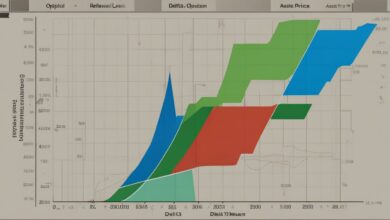Downward Pressure on Implied Volatility: Market Stabilization and Its Impact on Options Trading

Introduction
Understanding the complex relationship between market stabilization and implied volatility is crucial for options traders. Market stabilization often leads to a more predictable trading environment, reducing the demand for options as hedging instruments. This results in downward pressure on implied volatility, which in turn influences traders’ strategies.
Key Takeaways:
- Market stabilization exerts downward pressure on implied volatility, often leading to volatility compression.
- Experienced options traders need to adjust their strategies during stable market conditions.
- Lower implied volatility can indicate market confidence but also masks potential risks.
For those looking to delve deeper into how these dynamics affect your trading approach, consider exploring related strategies like the Call Ratio Spread. Additionally, understanding fundamental concepts such as What Is A Call Option? can provide further insight into navigating periods of low implied volatility.
This article aims to offer experienced options traders advanced insights into how market stabilization impacts implied volatility and what strategic adjustments can be made to optimize profitability.
Market Stabilization and Its Impact on Implied Volatility
Reduced Demand for Options as Hedging Instruments
In stable market conditions, the reduced demand for options as hedging instruments often leads to a decline in implied volatility levels. When markets are calm, traders and investors perceive lower risks, thereby reducing the necessity for protective measures such as buying options. This diminished demand directly impacts the pricing of options, causing implied volatility to decrease.
Key Takeaway: Options serve as vital hedging tools for managing risk. However, when market stabilization occurs, the urgency to hedge diminishes.
Demand Dynamics: The interplay of supply and demand significantly affects implied volatility. In periods of stability, the lower inclination to purchase options results in less upward pressure on their prices.
Exploring these dynamics helps you understand why implied volatility drops during stable periods, providing insights into how you might adjust your trading strategies accordingly.
Interaction Between Realized and Implied Volatility
Realized volatility reflects actual market movements over a given period, while implied volatility represents market expectations of future fluctuations. There’s a dynamic interaction between these two types of volatility:
- Mean-Reverting Behavior: Volatility tends to revert to its long-term mean over time. During periods of low realized volatility, implied volatility typically adjusts downward due to the anticipation that current stability will persist.
- Implications for Traders’ Strategies: This mean-reverting nature suggests that during stabilized markets with low realized and implied volatility, traders may anticipate potential future increases in volatility. This expectation could lead them to adopt strategies that benefit from eventual shifts in market conditions.
Understanding these interactions is crucial for optimizing your approach in different market environments.
For an in-depth explanation of how economic events influence options markets, you might find this expert insight quite useful.
Practical Example: Equity vs. Interest Rate Markets
Recently, while equity markets have experienced declining implied volatility due to stabilizing factors like improved economic outlooks and rising equity prices, interest rate markets have maintained elevated volatility levels. This divergence illustrates how different asset classes can react uniquely to stabilization forces:
- Equity Markets: Low implied volatility often indicates investor confidence and reduced uncertainty about future price movements.
- Interest Rate Markets: Elevated implied volatility reflects ongoing uncertainties and potential fluctuations driven by macroeconomic factors.
This contrast highlights the importance of monitoring various asset classes separately when adapting your strategies.
For a deeper understanding of why options might be better than stocks in volatile environments, consider exploring this comprehensive guide.
By analyzing these aspects, you gain a clearer picture of how market stabilization impacts implied volatility and what it means for your trading decisions. Keep these considerations in mind as you navigate through different market conditions.
Strategies to Optimize Profitability Amidst Downward Pressure on Implied Volatility
Experienced options traders can leverage several strategies to optimize profitability when faced with declining implied volatility levels. Adapting your approach to align with market conditions is essential for maintaining a competitive edge.
Adjusting Options Strategies
1. Focus on Spreads
- Utilize vertical spreads like bull call spreads or bear put spreads. These strategies involve buying and selling options with different strike prices, which can help mitigate the impact of low implied volatility.
- Example: By employing a bull call spread, you limit potential losses and reduce the cost of entering a position compared to buying a single call option outright.
2. Sell Options Premium
- Consider selling options to collect premiums in a low-volatility environment. Strategies such as covered calls or cash-secured puts can be effective.
- Example: Selling covered calls involves holding the underlying asset while selling a call option, allowing you to earn premium income without taking on additional risk.
3. Iron Condors and Butterflies
- Implement advanced strategies like iron condors and butterfly spreads that benefit from low volatility.
- Example: An iron condor involves selling an out-of-the-money put and call while simultaneously buying further out-of-the-money put and call options. This strategy profits from stable prices within a specific range.
Monitoring Open Interest
Keep an eye on open interest for insights into market trends and investor sentiment. High open interest in specific strikes can signal significant levels of support or resistance.
For more information, check out Unveiling the Hidden Power of Open Interest in Option Contracts.
Intraday Adjustments
Employ intraday trading techniques to capitalize on short-term price movements even in low-volatility environments. This requires close monitoring and quick decision-making.
Enhance your intraday skills by exploring this resource: Mastering Intraday Options Trading: Strategies, Considerations, and Best Practices.
Understanding Market vs Strike Prices
Evaluate the differences between market price and strike price to better position your trades.
For a deeper understanding, visit Market Price Vs Strike Price: What Is The Difference?.
Adapting your strategies in response to declining implied volatility can enhance profitability while managing risk effectively.
Conclusion: Staying Ahead in Options Trading through an Advanced Understanding of Market Stabilization and Implied Volatility Dynamics
Understanding the nuanced relationship between market stabilization and implied volatility is crucial for successful options trading outcomes. Experienced traders can make more informed trading decisions by recognizing how stable market conditions exert downward pressure on implied volatility.
Monitoring market conditions is essential. Adapting strategies based on real-time data allows traders to stay ahead of the curve. For instance, during periods of low implied volatility, focusing on strategies like iron butterflies can help maintain profitability. Learn more about this advanced strategy here.
To navigate options trading with confidence and tailor your approach to different market environments, consider exploring various broker types here. Using the right broker can significantly impact your trading efficiency and effectiveness.
Delving deeper into key concepts such as the Black Scholes Model also enhances your understanding of options pricing. This foundational knowledge is invaluable for adapting to changing market dynamics. Discover more about this model here.
By continually refining your strategies and staying informed, you position yourself for success in the ever-evolving world of options trading.








